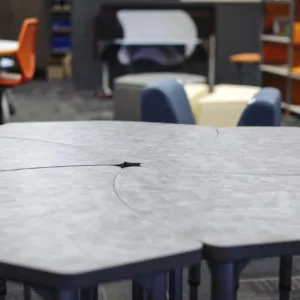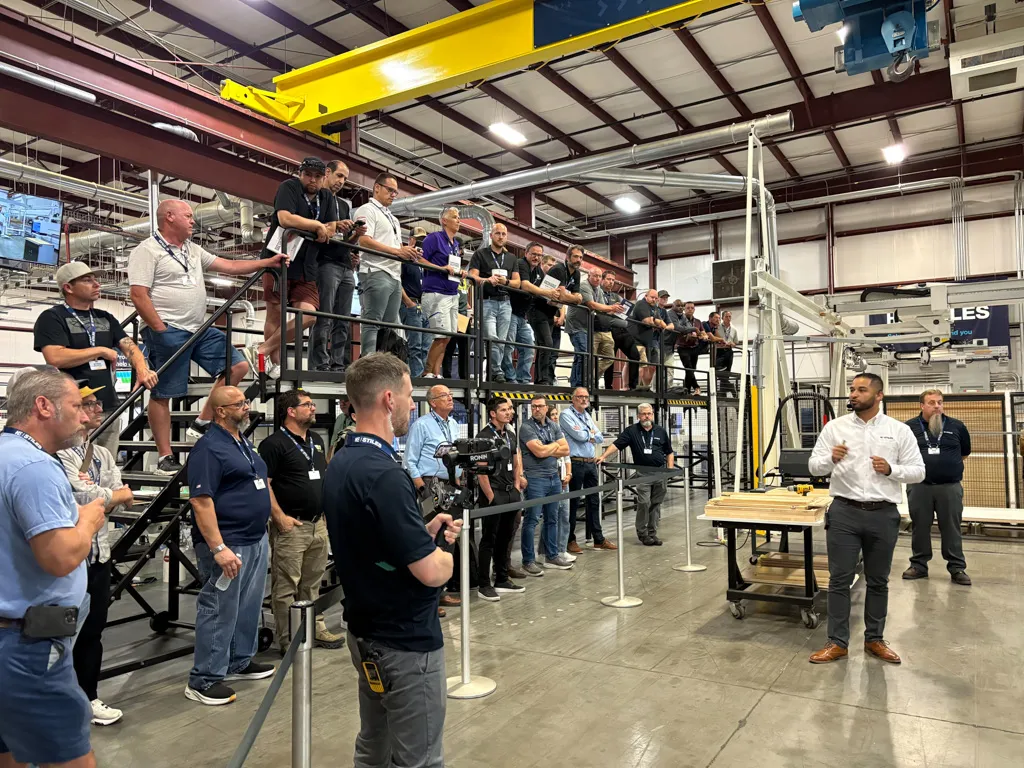Table of Contents
Laminate Works takes pride in solving customers’ problems
The story of Laminate Works is about more than a flexible OEM experiencing year-after-year growth while serving multiple market segments with a 96.69 percent quality on-time record. It’s about the successful application of modern manufacturing trends to panel processing.
Bert Clothier, president of Laminate Works, will be the first to say that when he started the company 20 years ago, his strategy wasn’t to become a thought leader harnessing the power of modern machine technology and analytics. Rather, the company was founded to solve a problem for a company in the elevator industry.
“Our vision is ‘to use our everyday ordinary lives to serve others.’ We’re not trying to sell something. We’re trying to solve problems,” Clothier said. “The other thing that is very unusual about what we’ve done is to focus on customers that have a problem that needs to be solved, not a specific customer base, market segment or product line.”
Instead of marketing custom HPL parts and HPL panels, Laminate Works markets capabilities.
The drive to solve problems leads Laminate Works to develop solutions—both for customers and internally—that integrate modern tools. Open-source software, demand-driven manufacturing and advanced planning/scheduling make Laminate Works an extremely flexible OEM partner, capable of producing high-precision goods at low or high volume with short lead times.
Simultaneously, by serving a wide variety of customers with similar needs and unique problems, Laminate Works receives something just as valuable as profit: market data. A classic OEM sells capacity on equipment to customers whose demand doesn’t justify their own investment. A modern JIT OEM such as Laminate Works uses advanced analytics to make predictive investments in technology and meet customers’ ongoing needs.
“As we continue to grow into a national company, we have to have capacity to respond and capabilities to solve problems,” Clothier said. “I pay very close attention to what problems customers are having and work hard on infrastructure today so we have a solid foundation to build on later.”

Responsiveness
Travis McElhany, vice president of sales and marketing for Laminate Works, said customers turn to Laminate Works for many reasons:
“Some people find us when they need traditional OEM work, like for a capability they don’t have in-house, proof of concept, assistance building to stock or short-term help with capacity. Sometimes, they’re adding a new machine that isn’t online yet, and we fill the gap until it’s up and running. Other customers outsource everything and look to us to make one or more parts of their product.
“We put a lot of custom solutions together, even developing ongoing stocking programs if the volume and timeline demand them. Along the way, we discover there are other things customers can use help with, so we end up growing relationships.”
Laminate Works collaborates with designers, purchasers, shop floor managers and owners from the industries it serves. “We don’t have a single market that is more than 20 percent of our business,” Clothier said. “The solutions are all different. It’s really taking the time to identify the real problem. Most of the time, people know what the pain is but not what the problem is.”
To stay tuned in, Laminate Works attends tech tours and trade shows—not to sell but to understand where market trends are headed and what capabilities could help customers. The sales team examines recent requests that Laminate Works did not have a response to and brainstorms what could be done to address unmet needs. Team members proactively stay on top of material technologies, maintain FSC certification and have panels tested to
look for the best way to manufacture in anticipation of solutions.

“If you understand the different substrate options, you know when you should use MDF versus particleboard or plywood. All three substrates have key traits that impact performance. We use board from Arauco, Roseburg, Georgia Pacific and other suppliers depending on the solution,” Clothier said. “But as CARB is changing board formulations to make materials better for the environment, they are getting more difficult to work with.


“Meanwhile, surfaces are getting better. HPL suppliers like Wilsonart, Formica, Nevamar and others are responding to customer demand with beautiful products. So we’re seeing larger format designs. Finishes are shinier, more matte, more durable, fingerprint resistant. As the HPL becomes more perfect, it also becomes more difficult to bond without telegraphing. It’s one of the reasons we are putting in a new Burkle PUR laminating line.”
Investments, infrastructure and logistics
Data tells Clothier that interest in PUR bonding has reached the point of critical mass to justify the investment. The new capability will have a positive impact on existing issues, such as allowing customers to specify thinner laminates to reduce cost, improving the bond strength to the substrate and reducing the number of panels rejected due to those challenges.
“Like with our contour edgebanders, if we can identify which of our customers would benefit from an investment and an efficient way to do it better than most people can do it in-house, we just gained a new capability and more solutions we can offer,” Clothier said. “And that increases time on my saws, my banders, my presses. So it is not just about that new profit center. It utilizes all those machines.”
As an OEM, speed to market is critical for Laminate Works. Maintaining available capacity and simplifying logistics are two ways to decrease lead times.
“We had two similar operations between Kansas City, Kansas, and Dallas. In July, we made the strategic decision to sell the Dallas facility and consolidate all capabilities in one location to increase capacity, add redundancy and eliminate unnecessary movement of materials if one plant was over- or under-booked,” McElhany said. “We typically bond up to 600 panels and process 1,500 parts per shift, depending on size and complexity. With all our assets in one place, we can scale up to meet new customer needs.”
With the decision made, Laminate Works quickly found a buyer for the Dallas operation—Wilsonart, which happened to already occupy the adjoining space in Dallas.
“We’re renovating our 100,000-square-foot facility in Kansas City, redoing front office space and reconfiguring the manufacturing floor to accommodate the PUR line and new material-handling automation,” McElhany said. “The goal is to have the front office renovation completed by our 20th anniversary in February 2019 and new machinery installed over the next 6 to 12 months.”
Laminate Works’ new investments in capabilities and infrastructure are in line with the company’s primary focus—solving problems on a national level with custom parts and programs. But sometimes the solutions Laminate Works provides have as much to do with information and logistics as panel processing.
Outsource/open source
Outsourcing benefits the industry as a whole. When leading-edge technologies are acquired by a few and utilized by many, it improves production, efficiency and quality for all. In modern times, the historical stigma of not making all of a product in-house is waning, but there are still problems to be solved for outsourcing to work.
“There are a couple reasons people avoid outsourcing,” Clothier said. “The biggest one used to be control. That is falling away. To me, the bigger barrier we have to overcome is how to get the necessary information to make what customers need us to make.”

Information is crucial to modern manufacturing, with thought leaders going so far as to say manufacturers must become software companies. Laminate Works, which is about to complete a five-year project of updating its systems and processes to leading-edge technology, has personal experience in solving information problems.
“Because we’ve created such an unusual company in how we move information, virtually none of the available ERP software was able to do what we wanted it to do. We have a lot of proprietary tools made in Access databases and Excel spreadsheets—things we’ve developed for internal use as well as to solve specific problems for customers. They are very elaborate and do pretty amazing things,” Clothier said. “But they don’t fit in the logic of existing software.
“Everything is open platform, so very robust. We have a SQL database that holds all our information, and we work with a company that creates applications out of our existing solutions. Their software goes into our apps, does its thing, then goes back to the cloud-based information bank. We use a platform that allows anyone in our company, from accounting to ordering to scheduling, to have real-time access to information,” Clothier said. “It eliminates double entry and solves some very complicated things with great agility.”
The first step in solving problems for Laminate Works is and always will be listening to customers. But the new information system gives the company more than increased functionality and efficiency. It provides data—data that can help analyze demand, optimize scheduling and inform future investments.
“There are a lot of in-house tools we’ve built to solve problems and be more nimble. The big thing all companies face when they grow is how to continue responding like customers expect,” Clothier said. “As we continue to grow year after year, it becomes more of a challenge to offer that level of service, but when your whole niche is service, you have a duty to make the efforts.”
Machinery matters
“When choosing equipment, we pay attention to who is leading the way. There’s a lot of great machinery out there, and relationships play a role. While reconfiguring our manufacturing floor, we’ve worked closely with many companies, including IMA, Stiles, Onsrud, Burkle and others.”
– Bert Clothier, president, Laminate Works.
Equipment in Laminate Works’ Kansas City facility:
– Black Brothers presses
– Schelling saws
– Onsrud routers
– IMA straight-line and contour edgebanders
– Homag boring machines
– Burkle PUR glue line—coming soon
“All together, the equipment amplifies our ability to function and meet demand in the near future. We also have redundancy to manage any maintenance or machine issues, so we are never really down.”
-Travis McElhany, vice president of sales and marketing, Laminate Works
Laminate Works solves problems for:
– Contract furniture
– Restaurant furniture
– School furniture
– Hospitality furniture
– Elevators
– Store fixtures
– Architectural casework









